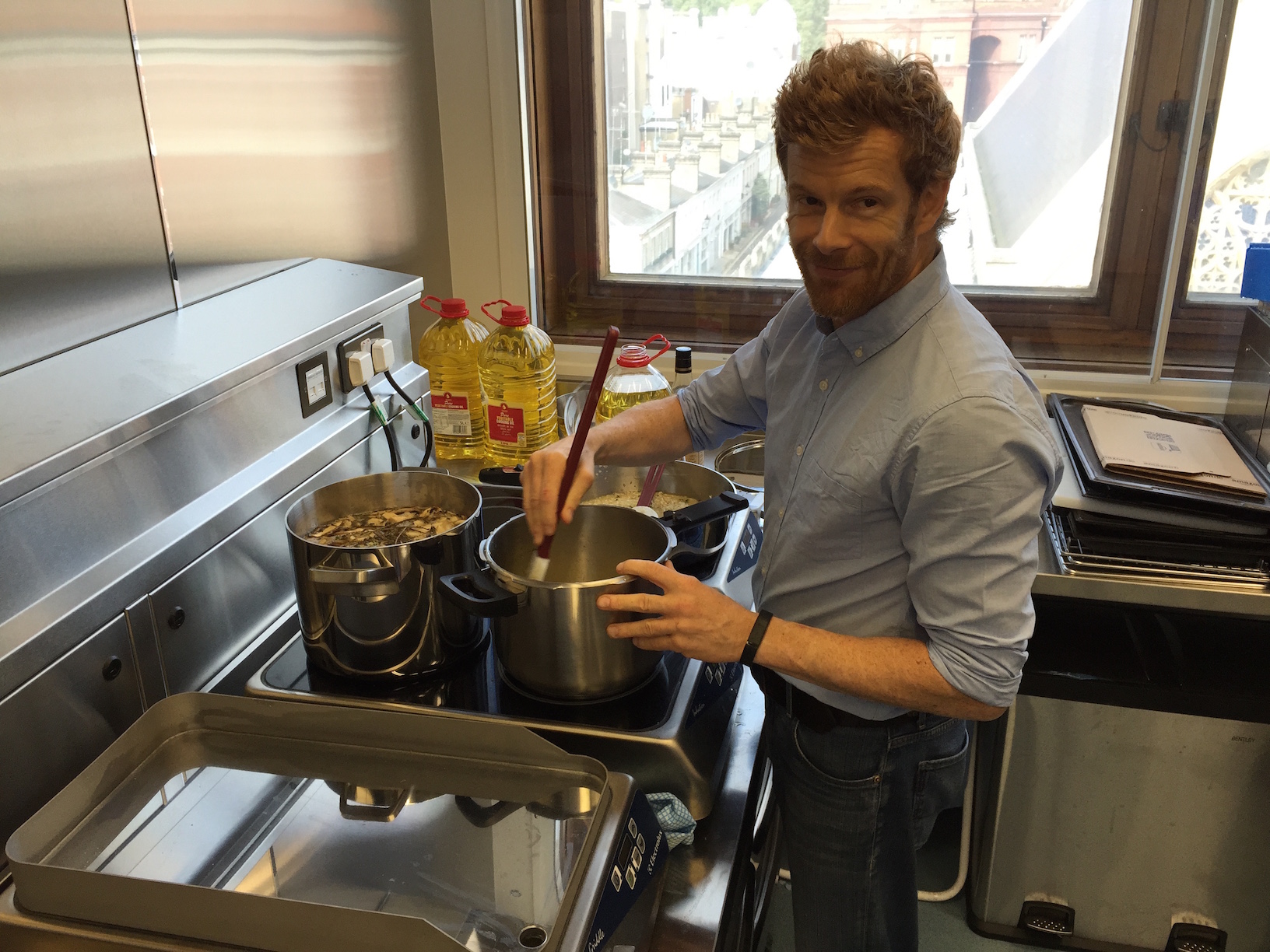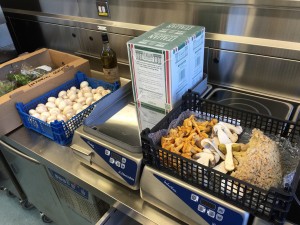
Our entire risotto project with Lara was inspired by J. Kenji López-Alt’s blog on pressure cooker made risotto. The actual project idea came from Dr Matthew Foreman who sent me a copy of a paper on the gelatinisation of starch in rice. We decided to investigate the effect of toasting rice, cooking temperature, and time on the consistency of risotto. Lara has already reported on some aspects of the work in earlier posts and we are currently writing up the results for a scientific paper. So that we can celebrate a successful project we decided to cook a mushroom risotto also testing the conclusions of Lara’s work in practice. Since making a risotto involves more than lab equipment, I asked my friend Tom Aikens for help.
We received all the ingredients for the risotto from Wild Harvest, supplier of the best quality ingredients, and great supporter of our Physics of Cooking lab! 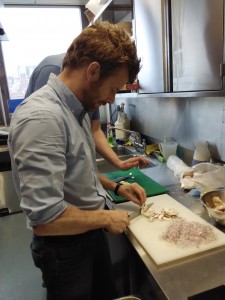 These included girolles, ceps and cauliflower mushrooms, white cup mushrooms, beautiful Italian lemons, shallots, chervil, thyme, outstanding Italian extra virgin olive oil and butter from Isigny-sur-Mer. We wanted to cook two batches of risotto: one the traditional and one in pressure cooker. We started up by peeling and chopping banana shallots and white cup mushrooms. The former for the base of the risotto, the latter for the mushroom stock which was based on a dark chicken stock from Wild Harvest. Before the sliced white cup mushroom made it to the stock we coloured them off by frying (using Maillard reaction to develop taste) in vegetable oil. When the mushroom was ready we added them to the stock and let it infuse. The shallots, garlic, thyme and bay leaves were fried off without colouring them in olive oil in a risotto pan and also in the pressure cooker. After a few minutes we put the carnaroli rice (turns out this is the best all around rice for risotto) in for a very short (less than a minute) toasting. Lara established during the project that the
These included girolles, ceps and cauliflower mushrooms, white cup mushrooms, beautiful Italian lemons, shallots, chervil, thyme, outstanding Italian extra virgin olive oil and butter from Isigny-sur-Mer. We wanted to cook two batches of risotto: one the traditional and one in pressure cooker. We started up by peeling and chopping banana shallots and white cup mushrooms. The former for the base of the risotto, the latter for the mushroom stock which was based on a dark chicken stock from Wild Harvest. Before the sliced white cup mushroom made it to the stock we coloured them off by frying (using Maillard reaction to develop taste) in vegetable oil. When the mushroom was ready we added them to the stock and let it infuse. The shallots, garlic, thyme and bay leaves were fried off without colouring them in olive oil in a risotto pan and also in the pressure cooker. After a few minutes we put the carnaroli rice (turns out this is the best all around rice for risotto) in for a very short (less than a minute) toasting. Lara established during the project that the 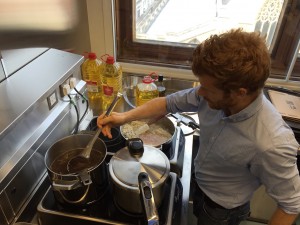 use of both high temperatures and long toasting times dramatically reduces the amount of starch the rice can release. In fact she found that ideal toasting temperature is around 100C for no longer than 1 minute. Once tasting was done we added Italian white cooking wine to the onion, garlic and rice mixture and let it absorbed by the rice. We then added the mushroom stock to both pans – for the traditional risotto little by little while for the pressure cooker version about 1:1.7 rice:stock volume ratio. Once the hot stock was in the pressure cooker, we put the lid on and pressurised it to cook the risotto for 5 minutes at medium pressure after which the pressure needs to be lowered fast before the risotto is overcooked. Pressurised pressure cookers tend to have ~120C inside so any additional minute can result in mushy, inedible rice!
use of both high temperatures and long toasting times dramatically reduces the amount of starch the rice can release. In fact she found that ideal toasting temperature is around 100C for no longer than 1 minute. Once tasting was done we added Italian white cooking wine to the onion, garlic and rice mixture and let it absorbed by the rice. We then added the mushroom stock to both pans – for the traditional risotto little by little while for the pressure cooker version about 1:1.7 rice:stock volume ratio. Once the hot stock was in the pressure cooker, we put the lid on and pressurised it to cook the risotto for 5 minutes at medium pressure after which the pressure needs to be lowered fast before the risotto is overcooked. Pressurised pressure cookers tend to have ~120C inside so any additional minute can result in mushy, inedible rice! 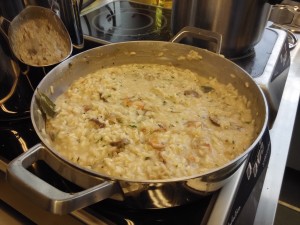 The best way to lower the pressure and therefore the temperature in a pressure cooker is to stick the closed pot under running cold water. After releasing the pressure we realised that the stock we added to the rice was too much and we had to remove some of it to bring the consistency to the right level. We reckon a 1:1.3-1.4 rice to stock v/v ratio is ideal. It is important to note that how the rice come out of the pressure cooker is initially disappointing – the grains appear well separated just like a good paella. However, the secret is in the whipping: the gelatinised starch needs to be removed from the outside of the rice grains and mixed in well. As soon as the mixing was done we finally had a beautiful, velvety risotto. Of course we finished off with salt and pepper, crème fraîche, butter, chervil and some of the wonderful pan fried wild mushrooms. It was outstanding and had a much better texture than the traditional one. Thank you Tom!
The best way to lower the pressure and therefore the temperature in a pressure cooker is to stick the closed pot under running cold water. After releasing the pressure we realised that the stock we added to the rice was too much and we had to remove some of it to bring the consistency to the right level. We reckon a 1:1.3-1.4 rice to stock v/v ratio is ideal. It is important to note that how the rice come out of the pressure cooker is initially disappointing – the grains appear well separated just like a good paella. However, the secret is in the whipping: the gelatinised starch needs to be removed from the outside of the rice grains and mixed in well. As soon as the mixing was done we finally had a beautiful, velvety risotto. Of course we finished off with salt and pepper, crème fraîche, butter, chervil and some of the wonderful pan fried wild mushrooms. It was outstanding and had a much better texture than the traditional one. Thank you Tom!
